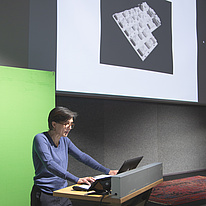The focus of this year's Graz Architecture Lectures held on 20 and 21 April in the hall of Kronesgasse 5, was placed on the concept of "The Infraordinary". Its title alludes to the term L’infra-ordinaire, coined by the French writer Georges Perec. In this context, the “infraordinary” is to be understood as an antithesis to the “extraordinary” and does not simply refer to the ordinary in a pejorative sense but explicitly to the non-extraordinary. In other words, to all those trivial spaces that we usually overlook or ignore. When applied to the field of architecture, the infraordinary encompasses everyday forms of architectural practice, supposedly banal architectures, quotidian usages of extraordinary architecture and intermediate forms of that which is worth seeing and that which is not. The seven lectures addressed questions around the viability of the concept of the infraordinary and its use in architecture.
The lecture series was opened by Lisa Eder and Fekry Helal, who introduced their journal Alltag (Everyday Life) – a periodical collecting contributions from the fields of photography, literature, the graphic arts and the humanities, which document everyday phenomena and practices.
In his lecture entitled "Object & Process", Alexander Hagner (gaupenraup +/-) argued for architecture to be evaluated first and foremost as a process rather than a finished object. Using the example of “Vinzirast-Mittendrin," a communal housing project where students and formally homeless persons live under one roof, Hagner illustrated the importance of joint efforts during the construction process, which was critical to the project’s success.
The third lecture, given by the Viennese architect Anna Wickenhauser, illustrated how the seemingly unremarkable can manifest itself as a work of architecture. Selected projects of her design practice––"Brunnenhaus Maria Siebenbrünn Türnitz" and "Hauptplatz & Rochusplatz Stadtschlaining"––exemplified her subtle treatment of historical elements and their contemporary transfiguration into an aesthetic of the mundane.
Elisavet Hasa dealt with the spatial-political dimension of the everyday. In her lecture, the co-founder of the research and design collective "Fatura Collaborative" shared insights from her research on the informal occupation and ad hoc transformation of flats and business premises into healthcare facilities, as they took place through solidarity initiatives during the economic crisis between 2010 and 2020 in Athens.
Dea Ecker and Robert Piotrowski took the notion of the banal as a starting point in their lecture and illustrated the design potential that can unfold out of ordinary usages and unspectacular building elements. This approach was exemplified through selected office projects, in which rather unspectacular construction elements, such as industrial conveyor belts or commercially available drainage pipes, were given a new function, thus turning into design elements that helped determine the further development of the design.
In his lecture "Architectures of Change", Branko Kolarević identified the category of time as an infraordinary element in the architectural design process of adaptive architecture. While ascribing the technologies of these responsive structures and interactive systems to the "extraordinary" and situating the central aspect of transformation (change) in the "ordinary", he defines time as an "infraordinary" element that fundamentally guides this discourse of change. This thesis was illustrated by examples from his book Building Dynamics: Exploring Architecture of Change (2015, together with Vera Parlac).
Finally, literary scholar Johanna-Charlotte Horst concluded the Graz Architecture Lectures by sharing her research on the literary work of George Perec, highlighting, in particular, the interferences between literature and architecture. Not only was Perec repeatedly engaged in the description of everyday spaces, rooms, streets and squares, but he also made use of architectural-spatial structures as a narrative strategy in his novels. Thus, architecture appears in his work as an object as well as a literary method.
The event was hosted by Daniel Gethmann (akk) and Petra Eckhard (GAM Labor). The discussion on “The Infraordinary” will be continued in the form of a publication, the 20th issue of GAM - Graz Architecture Magazine, for which Matthias Castorph and Julian Müller (Insitute of Design in Existing Structures and Architectural Heritage Protection) will be responsible as Guest Editors.
Text: Petra Eckhard und Julian Müller
Übersetzung: Max B. Spamer













